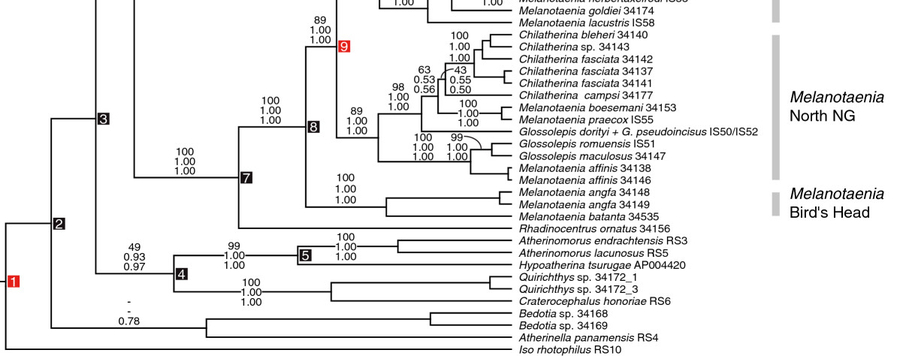
Age estimates for an adaptive…
Background:
The Malili Lakes system in central Sulawesi (Indonesia) is a hotspot of freshwater biodiversity in the Wallacea, characterized by endemic species flocks like the sailfin silversides (Teleostei: Atherinomorpha: Telmatherinidae) radiation. Phylogenetic reconstructions of these freshwater fishes have previously revealed two Lake Matano Telmatherina lineages (sharpfins and roundfins) forming an ancient monophyletic group, which ishowever masked by introgressive hybridization of sharpfins with riverine populations. The present study uses mitochondrial data, newly included taxa, and different external calibration points, to estimate the age of speciation and hybridization processes, and to test for phylogeographic relationships between Kalyptatherina from ancient islands off New Guinea, Marosatherina from SW Sulawesi, and the Malili Lakes flock.
Results:
Contrary to previous expectations, Kalyptatherina is the closest relative to the Malili Lakes Telmatherinidae, and Marosatherina is the sister to this clade. Palaeogeographic reconstructions of Sulawesi suggest that the closer relationship of the Malili Lakes radiation to Kalyptatherina might be explained by a ‘terrane-rafting’ scenario, while proto-Marosatherina might have colonized Sulawesi by marine dispersal. The most plausible analysis conducted here implies an age of c. 1.9 My for the onset of divergence between the two major clades endemic to Lake Matano. Diversification within both lineages is apparently considerably more recent (c. 1.0 My); stream haplotypes present in the sharpfins are of even more recent origin (c. 0.4 My).
Conclusions:
Sulawesi’s Telmatherinidae have most likely originated in the Sahul Shelf area, have possibly reached theisland by both, marine dispersal and island/terrane-rafting, and have colonized the Malili Lakes system from rivers.
Estimates for the split between the epibenthic sharpfins and the predominantly pelagic to benthopelagic roundfins in Lake Matano widely coincide with geological age estimates of this rift lake. Diversification within both clades clearly predates hybridization events with stream populations. For Lake Matano, these results support a scenario of initial benthic-pelagic divergence after colonization of the lake by riverine populations, followed by rapid radiation within both clades within the last 1 My. Secondary hybridization of stream populations with the sharpfins occurred more recently, and has thus most likely not contributed to the initial divergence of this benthic species flock.






